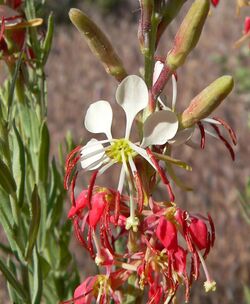Biology:Oenothera suffrutescens
| Oenothera suffrutescens | |
|---|---|

| |
| Scientific classification | |
| Kingdom: | Plantae |
| Clade: | Tracheophytes |
| Clade: | Angiosperms |
| Clade: | Eudicots |
| Clade: | Rosids |
| Order: | Myrtales |
| Family: | Onagraceae |
| Genus: | Oenothera |
| Species: | O. suffrutescens
|
| Binomial name | |
| Oenothera suffrutescens (Moc. & Sessé ex Ser.) W.L.Wagner & Hoch
| |
| Synonyms | |
Oenothera suffrutescens (syn. Gaura coccinea) is a species of flowering plant in the evening primrose family known as scarlet beeblossom[1] and scarlet gaura.[2][3][4][5]
Description
Scarlet beeblossom is a perennial herb growing from a woody base and heavy roots. The stems may reach anywhere from 10 centimeters in height to over a meter and sprawling, and they are often covered in small, stiff hairs. The thin to thick clumps of stems are covered in linear to somewhat oval-shaped leaves one to seven centimeters long. Atop the stems are spike inflorescences of several flowers each. The flower has four long, stiff sepals which open and fall away from the flower to lie reflexed toward the stem. There are four spoon-shaped petals which are white to yellowish and may turn pink with age. Each flower has eight long stamens with large red, pink, or yellowish anthers arranged around a long stigma. The flowers are strongly scented.[6] The fruit is a woody capsule under a centimeter long.
Distribution
The plant is native to much of North America, especially the western and central sections. It can be found in many habitats and is occasionally an urban weed. In 2016 NatureServe assessed Oenothera suffrutescens under the name Gaura coccinea as globally secure (G5).[7]
Cultivation
Scarlet beeblossom is occasionally grown in wildflower gardens for the resemblance of its flowers to butterflies and the pleaseant scent they produce when blooming. However, some like the author Claude A. Barr dislike that it spreads by deep rhizomes making it difficult to control in a garden setting.[6]
References
- ↑ "Gaura coccinea". Natural Resources Conservation Service PLANTS Database. USDA. https://plants.usda.gov/core/profile?symbol=GACO5. Retrieved 19 January 2016.
- ↑ "Oenothera suffrutescens (Moc. & Sessé ex Ser.) W.L.Wagner & Hoch". Royal Botanic Gardens, Kew. https://powo.science.kew.org/taxon/urn:lsid:ipni.org:names:77092961-1. Retrieved 19 July 2020.
- ↑ Calflora Database: Oenothera suffrutescens (Wild honeysuckle, linda tarde)
- ↑ Jepson Manual eFlora (TJM2) treatment of Oenothera suffrutescens
- ↑ (xls) BSBI List 2007, Botanical Society of Britain and Ireland, https://bsbi.org/download/3542/, retrieved 2014-10-17
- ↑ 6.0 6.1 Barr, Claude A. (1983). Jewels of the plains : wild flowers of the Great Plains grasslands and hills. Minneapolis: University of Minnesota Press. p. 88. ISBN 0-8166-1127-0.
- ↑ NatureServe (2023). "Gaura coccinea". Arlington, Virginia: NatureServe. https://explorer.natureserve.org/Taxon/ELEMENT_GLOBAL.2.153198/Gaura_coccinea.
External links
- Lady Bird Johnson Wildflower Center Native Plant Information Network−NPIN profile of Gaura coccinea (Scarlet beeblossom)
- UC CalPhotos gallery
Wikidata ☰ {{{from}}} entry
 |


